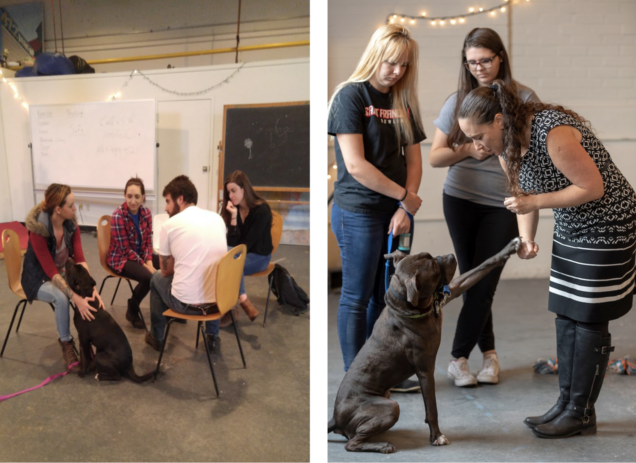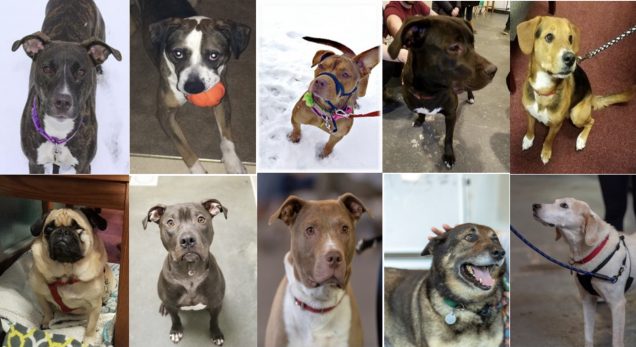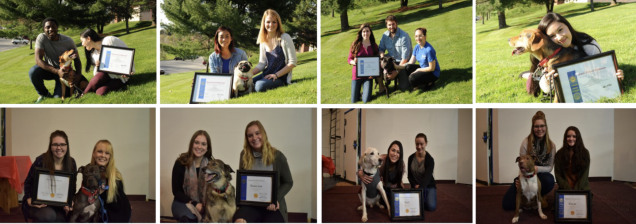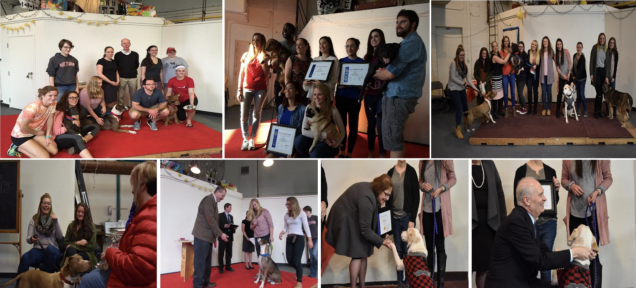For the Love of Dogs
An Academia-Community Partnership Targeting a Mutual Goal
By Shlomit Flaisher-Grinberg, Saint Francis University
Abstract
One of the most rewarding yet challenging tasks for a college or university educator is to construct an application-based course that integrates theoretical concepts with active, hands-on, career-oriented practices. At times, the task can only be accomplished if an academia-community cooperative team is formed. The current project was designed to create and implement a partnership between the Department of Psychology at Saint Francis University and the staff and volunteers at the Central Pennsylvania Humane Society in Altoona, PA. The project enabled students to foster shelter dogs for an academic semester, to use psychology-based concepts to train dogs for obedience and agility, and to explore topics relevant to animal-assisted therapy, education, and intervention. The goal was for this enterprise to do several things: enable the transformation of the traditional “Psychology of Learning” course into a dynamic and skill-oriented course; support the professional development of students and the hard work of staff and volunteers at the Humane Society; and contribute to the successful adoption of shelter dogs. Students’ grades were used to assess success in the class, anonymous surveys were used to assess students’ attitudes towards the learning outcomes of the class, and the success of the program was evaluated using the ratio of dogs’ adoption at the end of the semester. Results indicated that students attain an appropriate grade distribution in the class and consider it beneficial towards their academic and professional development. The adoption ratio following the conclusion of the semester is 100%. Future directions for the project are discussed.
Introduction
Psychology is the scientific study of mind and behavior. It spans topics such as emotion, motivation, cognition and physiology, and explores normal and abnormal processes which affects human health and well-being (Schacter et al.). The “Psychology of Learning,” a course which focuses on the analysis and modification of behavior, is offered as part of the undergraduate psychology curriculum at many academic institutions (Trench LS). The course teaches about permanent change in a learner’s knowledge, skills, and responses through habituation, sensitization, and classical and operant conditioning (Schacter et al.; Domjan Michael). While the course examines traditional and contemporary theories of learning, it also has the potential to include hands-on active and interactive exercises so students can apply learned concepts to their daily lives. To accomplish this goal, many institutions provide students with the opportunity to work with non-human animals (most commonly rats) as an integral part of the course design (Elcoro and Trundle; Hazel et al.; Hunt and Macaskill; Trench LS).
Given the demonstrated intelligence, and communicative and adaptable nature of dogs (Elgier et al.; Huber et al.; Miklósi; Reid), as well as the interactive nature of the “Psychology of Learning” class, it may seem surprising that very few, if any, Psychology-based curriculums integrate dogs into the course. Partial explanations may include space and funding constraints or the fact that while academic institutions can offer various resources to their students (including technology-enhanced classrooms, dedicated faculty, and supportive staff and administration), most academic institutions have no direct supply of dogs.
A possible solution to this problem is the creation of an academia-community partnership with a local animal shelter. Estimates are that each year, 5-8 million dogs and cats enter U.S. animal care and control facilities, and each year 3-4 million are euthanized (Pets by the Numbers). Many of the animals entering US shelters display various maladaptive behaviors. They may engage in excessive locomotion and barking in the kennel (Protopopova et al.). They may have behavioral issues (e.g., growling, biting, jumping) and inadequate training (e.g., house training). They may also have problems with socialization (towards humans or other animals). These behaviors, which can be aggravated by the high level of noise, confined spaces, and reduced levels of human contact that are typical to the shelter environment (Thorn et al.), may impede successful adoption. Since students enrolled in the “Psychology of Learning” focus on theoretical concepts of behavioral analysis and modification, the inclusion of shelter dogs can help facilitate their learning outcomes. The inclusion also alters dogs’ behavioral rehabilitation and adoption outcomes.
In line with this logic, the Department of Psychology at Saint Francis University (SFU) formed an alliance with the Central Pennsylvania Humane Society (CPHS) to create the “Canine Learning and Behavior” class, a community-based engaged learning course. It was hypothesized that the class would enrich the experience and success of enrolled students, facilitate their career-building efforts, advance their preparation towards graduate-school, and support the dedicated work of shelter staff and volunteers. It would also allow for the behavioral rehabilitation of shelter dogs, which could help adoption rates.
Method
To create the “Canine Learning and Behavior” course, the Department of Psychology at SFU and the staff and volunteers at CPHS identified common goals to generate a unified definition of the course. They also selected personnel to engage in curriculum design, and established the appropriate procedures required to support community-based teaching within the institutional classroom. Learning outcomes were evaluated using students’ grades, and the perceived contribution of the class to students’ knowledge/comprehension and skill development. I assessed their preparation for future occupation with anonymous surveys that included the following items: 1)“The lectures contributed to my knowledge/comprehension of the material” 2) “The (dog-centered) labs contributed to my knowledge/comprehension of the material” 3)“The class was relevant to my chosen education/occupation” 4) “Enrollment into the class contributes to my future education/occupation” 5) “I will use the skills acquired in the course in my future education/occupation”, and 6) “I will integrate dogs into my future education/occupation” (Likert scale distributions: 5=strongly agree, 4=agree, 3=neutral, 2=disagree 1=strongly disagree). Surveys also solicited qualitative measurement of attitudes towards the class via student feedback, and the success of the program was evaluated using the ratio of success in the placement of dogs into adoptive families. All procedures were approved by the SFU Institutional review board (IRB) and by the SFU Institutional Animal Care and Use Committee (IACUC, Protocol # 00017).
Results
Once CPHS was identified as a possible community partner and the Director of the CPHS agreed to collaborate with SFU to develop the class, the course’s goals were established based on the mission and vision of both partners. The identified mutual objectives were: 1) Support the CPHS’s mission to prevent animal neglect and cruelty through education and enforcement. 2) Support the CPHS’s vision to meet the needs of animals in our community through communication, compassion, and conviction. 3) Facilitate SFU’s mission to provide its students with inspirational education opportunities for personal and career enhancement. 4) Respect and use ethical and scientific approach to solve problems related to the field of psychology, learning, and behavior.
Second, a curriculum was designed to integrate classroom-based lectures on the theoretical foundations of the “Psychology of Learning” field with hands-on labs to provide an applicable approach to dog training/behavioral rehabilitation. Lectures and labs were co-taught by a member of the SFU Department of Psychology, Dr. Shlomit Flaisher-Grinberg, and a member of the CPHS staff, Ms. Megan Stanton, (see Picture 1 below). Students attended lectures on topics such as habituation, sensitization, and classical and operant conditioning (Schacter et al.; Domjan), and applied their knowledge in lab sessions by training dogs for obedience (e.g., sit, down, stay, leash-walking), agility (obstacle course), and animal-assisted activities (appropriate behavior in classrooms, in a crowd, around medical equipment, around children and elderly individuals, etc.).
Various procedures and precautions were taken in order to allow the integration of dogs into the campus environment. The SFU Residence Life Office identified animal-approved housing so students could live with the dogs and monitor their progress. Appropriate classrooms were selected so students could work with the dogs on campus. The SFU IACUC implemented human and animal safety regulations, and campus police were notified about the approved presence of dogs in pre-specified campus areas (dogs were not allowed in dining and biology/chemistry lab areas). SFU provided financial support (via Excellence in Education, Curriculum Development, and Special Topic Grants to Dr. Flaisher-Grinberg), and CPHS provided dog food, crates, collars, leashes, and veterinary support.

Thus far, the class has been administered in spring 2016, spring 2017, and fall 2018. It has included a total of 27 students and 10 dogs. Students’ demographic distribution included 24 females and 3 males; 12 students were in their junior year and 15 were seniors. Students had various majors (13 psychology, 9 biology, 3 occupational therapy/psychology, 1 nursing/psychology, and 1 social work/psychology). Dogs were of different sex, breeds and ages. There were 6 males and 4 females ranging in age from 8 months to 10 years. The mixes included Pitbull (5), Boxer (1), Pug (1), Beagle (1), Shepherd (1) and Hound (1). Two of the dogs had congenital sensory deficits, a unilateral hearing loss in one of the Pitbull mix females, and a congenital lack of right eye in the Pug mix. Several dogs had health issues (teeth decay in the Shepherd mix, various illnesses in the Hound mix), and many had various behavioral issues (lack of house training, lack of human and/or dog-socialization, lack of general training). Nine dogs were surrendered for mostly unknown reasons, and 1 had been found as a stray (see Picture 2 below).

The formal evaluation of students’ success yielded the mean final grades of 92.38 (SD=5.844) during the 2016 spring semester, 93.42 (SD=7.221) during the 2017 spring semester, and of 92.54 (SD=4.225) during the 2018 fall semester. Analysis of responses to the anonymous surveys assessed students’ perception of learning outcomes and demonstrated positive perception of the course’s contribution to knowledge/comprehension, skill development, and future education/occupation (see Table 1 below).
| Survey Item | 2016
Mean (SD) |
2017
Mean (SD) |
2018
Mean (SD) |
| 1) the lectures contributed to my knowledge/comprehension of the material | M=4.66 (SD=0.50) | M=4.71 (SD=0.48) | M=4.28 (SD=1.49) |
| 2) the labs contributed to my knowledge/comprehension of the material | M=4.66 (SD=0.70) | M=4.71 (SD=0.48) | M=4.28 (SD=1.49) |
| 3) the class was relevant to my chosen education/occupation | NA | M=4.71 (SD=0.48) | M=4.43 (SD=1.13) |
| 4) enrollment into the class contributed to my future education/occupation | NA | M=4.85 (SD=0.37) | M=4.57 (SD=0.78) |
| 5) I will use the skills acquired in the course in my future education/occupation | NA | M=5.0 (SD=0.00) | M=4.57 (SD=0.78) |
| 6) I will integrate dogs into my future education/occupation | NA | M=5.0 (SD=0.00) | M=4.13 (SD=1.07) |
Table 1. Students’ perception of learning outcomes; survey analysis. Time of assessment: end of the semester. Likert Scale: 5=strongly agree, 4=agree, 3=neutral, 2=disagree 1=strongly disagree (n = 9, 2016; n=7, 2018; n= 9, 2018).
Students’ qualitative feedback was very positive, and included the following comments:
“I love how hands-on the course was. It made learned concepts applicable to everyday situations & to my future career.”
“Living with a dog made this experience so much better and made me appreciate the class on a deeper level.”
“Both professors were extremely knowledgeable and passionate about this subject. They make a great team together and make the class very enjoyable” … “I really enjoyed having [Ms. Stanton] around to help with the animals. She really knew what she was talking about. Her help and advice made the class truly successful” … “I just wanted to say thank you. This class has been my favorite I have taken at SFU. It has given me so much. What I learned will help me in the future. Knowing that I helped a dog in its journey to finding a forever home means a lot to me.”
Surprisingly, many students commented that among the benefits of the class was their newly acquired sense of maturity and responsibility, which they attributed to the requirement to provide care, training, and guidance to their fostered dogs throughout the entire semester. All the dogs were adopted by the end of the semester, and follow-up interactions indicated that no dogs had exhibited any behavioral issues or been re-surrendered to local shelters/rescue groups (see Picture 3 below).

Unexpected results included the high level of excitement demonstrated by the campus community. Students enrolled into the “Canine Learning and Behavior” course and their fostered dogs were invited to participate in many events on campus and to deliver various dog-centered events. In light of this interest, the students have decided to end each semester with what they have named a puppy graduation that includes a graduation certificate and an “SFU Graduate” collar tag. Many students, staff and personnel attended these events, and the CPHS and adopting families celebrated a successful semester (see Picture 4 below). The local community embraced the students and the dogs, as indicated by invitations to visit local nursing homes, public libraries, and elementary schools, as well as by media coverage.’

Discussion
Results demonstrated that the project successfully enabled the creation of an academia-community alliance, supporting the attainment of several mutual goals: 1) the formation of an active, interactive and applicable learning experience, facilitating learning outcomes and allowing students to translate academic materials into newly acquired skills; 2) The creation of a novel form of academia-community teaching opportunity, inviting community representatives into the classroom and allowing students to step outside of academia and into their local community; and 3) The generation of an inclusive network of professionals, representing various sectors of the academia and public communities, all working together to meet the needs of shelter dogs through communication, compassion, and conviction.
Throughout the semester, students were able to foster and live with shelter dogs. Students learned to apply theoretical concepts such as classical and operant conditioning to dog obedience and agility, and they were introduced to special topics such as animal-assisted therapy, education, and intervention. These experiences would not have been possible without the formation of a community engagement partnership, defined by the Carnegie Foundation as “the collaboration between institutions of higher education and their larger communities for the mutually beneficial exchange of knowledge and resources in the context of partnership and reciprocity (“Carnegie Community Engagement Classification”). Given its positive effects on students, dogs, the campus community, and the general community, it is suggested that such partnerships can span beyond the limits of this specific course to multiple subjects, classrooms, and learning environments.
While the project clearly offers many benefits to humans and animals alike, its implementation into additional locations may pose difficulties. First, not all academic campuses allow non-working dogs on property, and not all landlords agree to rent a house to a student who is fostering a dog. Second, some individuals within the campus community suffer from allergies or dog-phobia, so precautions should be employed. Third, since one cannot know a shelter dog’s background, an experienced professional should conduct a proper evaluation of the dog’s temperament, attitude, and behavioral repertoire. In addition, standard operation protocols should be available for contingencies such as a dog’s escape or injury, as well as injury to an individual. Finally, all relevant administrators and offices (e.g. department chairs and deans, campus police, and residence life) should be invited to contribute to the effort to plan and design the class.
To summarize, the “Canine Learning and Behavior” course enabled the bridging of academic curriculum with real-world application through the formation of an academia-community partnership. This avenue of community-based learning was possible because of the dedicated work of personnel from both communities. A lot of work, as well as genuine care, passion, and motivation, enabled this project. We hope the project will prosper and even inspire other learning communities to initiate partnerships to accomplish mutual goals.
Acknowledgments
This project would not have been possible without the following: Dr. Timothy Whisler, Former Dean of the School of Arts and Letters; Dr. Donald Walkovich, Dean of the School of Health Sciences and Education; Dr. Karan Powell, Interim Vice President for Academic Affairs; Fr. Josef Lehman, Vice President for Mission Integration; Ms. Lisa Boland, former director of the CPHS and partner in creating the course; Ms. Megan Stanton, co-instructor and treasured community partner; Ms. Briana Risbon, Volunteer coordinator at the CPHS and treasured community partner; Dr. Stephen Baker,Chair of the Psychology Department; Ms. Melissa Garrity, Administrative Assistant to the Psychology Department; Dr. Stephen Gilmour, Professor Emeritus of Psychology; Ms. Lisa Georgiana, Director of the Center for Community Engagement; Dr. Randy Frye, Dean of the School of Business; Mr. Jim Donovan, Chair of Fine Arts Department; Mr. Donald Miles, Director of Residence Life; Ms. Jacqueline Mazeika; Dr. Marnie Moist; Dr. Olivia Pethtel; Mr. David Wilson; Dr. Wayne Powel; SFU Campus Police; all the students enrolled in the class; Katherine Roos, Sabrina Palguta, Lauren Olek, Samantha Zeiders, Jeremy Gelpi, Megan Hayden, Allison Nedrow, Elizabeth Schaffner, Kristyn Wendeiker, Margaret Connley (2016); Abu Fofanah, Alix Hochard, Hannah Pelger, Alexander Romeo, Paige Mclean, Christine Geiger, Alicia Tiberino, Natalie Tedjasukmana, Kelsie Marconi (2017); Taylor Clark, Allyson Taureck, Hannah Keeley, Kelly Kramer, Cecilia Graze, Danielle Choisez, Ashley Lehman, Megan Alborg (2018).
Works Cited
